Oatmeal Rolls with Molasses
Step-by-step instructions for making perfect yeasted oatmeal dinner rolls with molasses that the whole family will devour.
Servings: 12 rolls
Calories: 239.1kcal
Equipment
- Kitchen scale
- Bench Scraper
- 9" Cake Pan Or 9-inch Springform Pan
Ingredients
- ¼ cup lukewarm water (110˚- 115˚F)
- 2 teaspoons active dry yeast, or 1 ½ teaspoons if baking at high altitudes
- Pinch sugar
- ¾ cup oat milk, add ¾ extra teaspoon if baking at high altitudes
- ½ cup unsalted butter, cut into cubes
- 1 tablespoon brown sugar, the link shows you how to make your own!
- ¾ cup rolled oats, plus more for sprinkling on top before baking
- 2 tablespoons molasses
- 2 ½ teaspoons kosher salt
- 1 large egg
- 11.25 ounces unbleached bread flour, (318 grams or 2 ½ cups)
- 1 tablespoon olive oil
- 2 tablespoons unsalted butter
Instructions
Proof the Yeast
- Fill a measuring with ¼ cup lukewarm water (110˚-115˚F). Use a thermometer to check the temperature of the water. Stir in the yeast with a pinch of sugar. Place it in a warm spot in the kitchen. Let stand until bubbly. It should get bubbly within 20 minutes. If not, the yeast may not be good any longer.
Make the Dough
- Heat the oat milk to very hot. It doesn't need to be simmering, but should be steaming, and hot enough to melt butter.I typically use the microwave oven for this.
- Place the pats of butter in a large mixing bowl. Pour the hot oat milk over them. When they melt, stir in the brown sugar, oats, molasses and salt. Stir the mixture with a large wooden or metal spoon until smooth.
- Cool slightly and add the egg. Mix well, and add the yeast and its liquid. Mix well again.
- Add the flour, 1 cup at a time, using a flexible bench scraper. A dough will form as the flour is incorporated. Work the dough until all the flour is absorbed into the dough. The dough will lose its sheen when you've added enough flour. (If it's humid where you live, you may need up to 3 cups of flour (13.5 ounces).)
First Rise
- Oil a clean, large mixing bowl, and clear out an area for it in the refrigerator. Transfer the dough into the bowl, and turn the dough over to coat it with oil on all sides. Cover with plastic.
- Chill in the refrigerator for at least 2 hours. An overnight chilling is even better. It will rise some, but not double in size.
Shape the Rolls
- Turn out the chilled dough onto a lightly floured work surface, and knead it a few times. Weigh the dough, and divide by 12. Cut and divide the dough into 12 equal-sized balls. I use a straight edge bench scraper for this.Cover with plastic.
- Working with one ball at a time, press it into a flat square using your fingers.
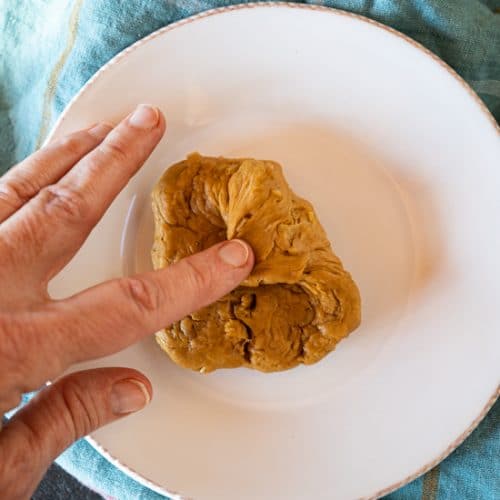
- Next, tuck the four corners of the square into the center. Gently roll the folded dough in your palm to re-form a ball.
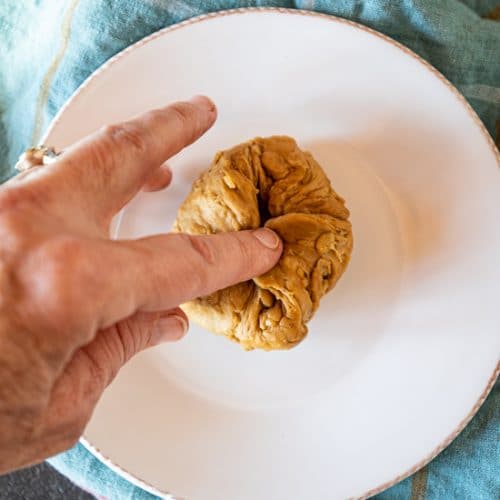
- Place each ball, seam-side down, in a well-buttered 9-inch round pan. Brush their tops with one-half of melted butter, and sprinkle with a few rolled oats. Cover with plastic, and place in a warm spot of the kitchen that's free of drafts. I place it in the microwave oven with a cup of hot water. (Just remember not to turn on the microwave!)
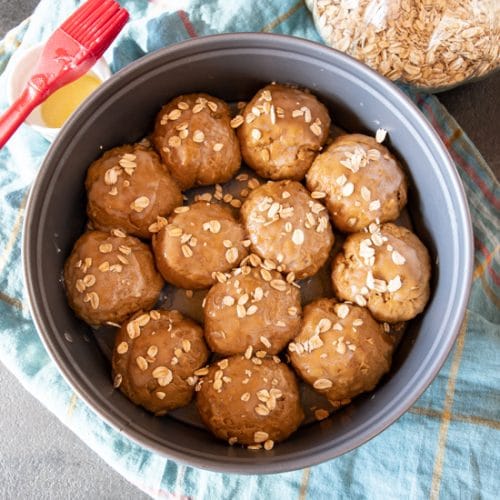
- Let rise until doubled in size, about two hours. (In high altitudes, this may take as short as 1 hour.)
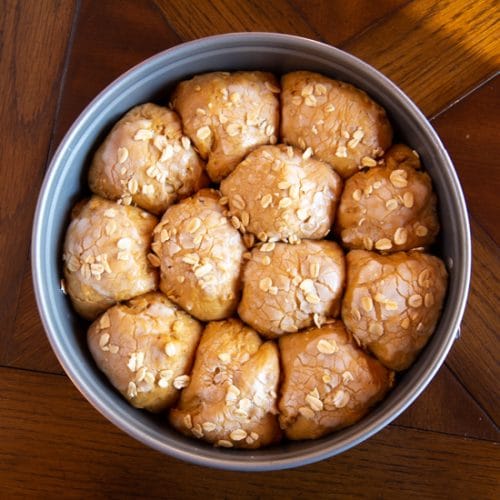
Bake the Rolls
- Preheat the oven to 350˚F. Remove the plastic, and bake the rolls for 35 - 40 minutes at sea level, or as long as 50 minutes at high altitude. The rolls should sound hollow when tapped, and the internal temperature should be 190˚ - 200˚F at sea level, and at least 180˚ - 185˚F at high altitude.
- Remove from the pan onto a cooling rack, and baste with the remaining butter. Allow to cool for 5 - 10 minutes (if you can) before serving.
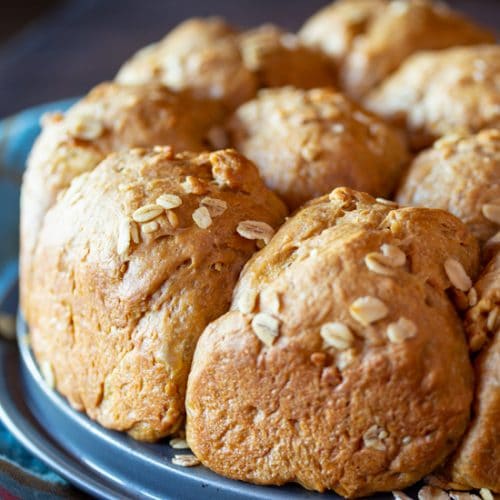
- These rolls freeze well, and will keep in the refrigerator for 1 week or longer. I always warm them a little before serving again.
Notes
Tips For Making Oatmeal Rolls
If using oat milk instead of dairy-based milk, the milk won't scald in the same way. Just heat it up to very warm - no need for it to reach a simmer. The microwave oven works very well for this.
Be sure to cool the liquid before adding the eggs. If it's too warm, the eggs will start to resemble scrambled eggs.
Don't expect the rolls to rise a great deal in the first rising since it's done in the refrigerator. They definitely rise, just not a lot at this stage. A refrigerator rise causes a slow rise, and the slower the rise, the more flavor gets created.
Follow the instructions for shaping the rolls. This creates layers of structure to them. After the first one, shaping goes very quickly.
Nutrition
Calories: 239.1kcal | Carbohydrates: 27.9g | Protein: 4.9g | Fat: 12.1g | Saturated Fat: 6.5g | Polyunsaturated Fat: 0.9g | Monounsaturated Fat: 3.6g | Trans Fat: 0.4g | Cholesterol: 40.9mg | Sodium: 501.4mg | Potassium: 115.9mg | Fiber: 1.4g | Sugar: 4.8g | Vitamin A: 348.5IU | Vitamin C: 0.002mg | Calcium: 41.5mg | Iron: 0.8mg
